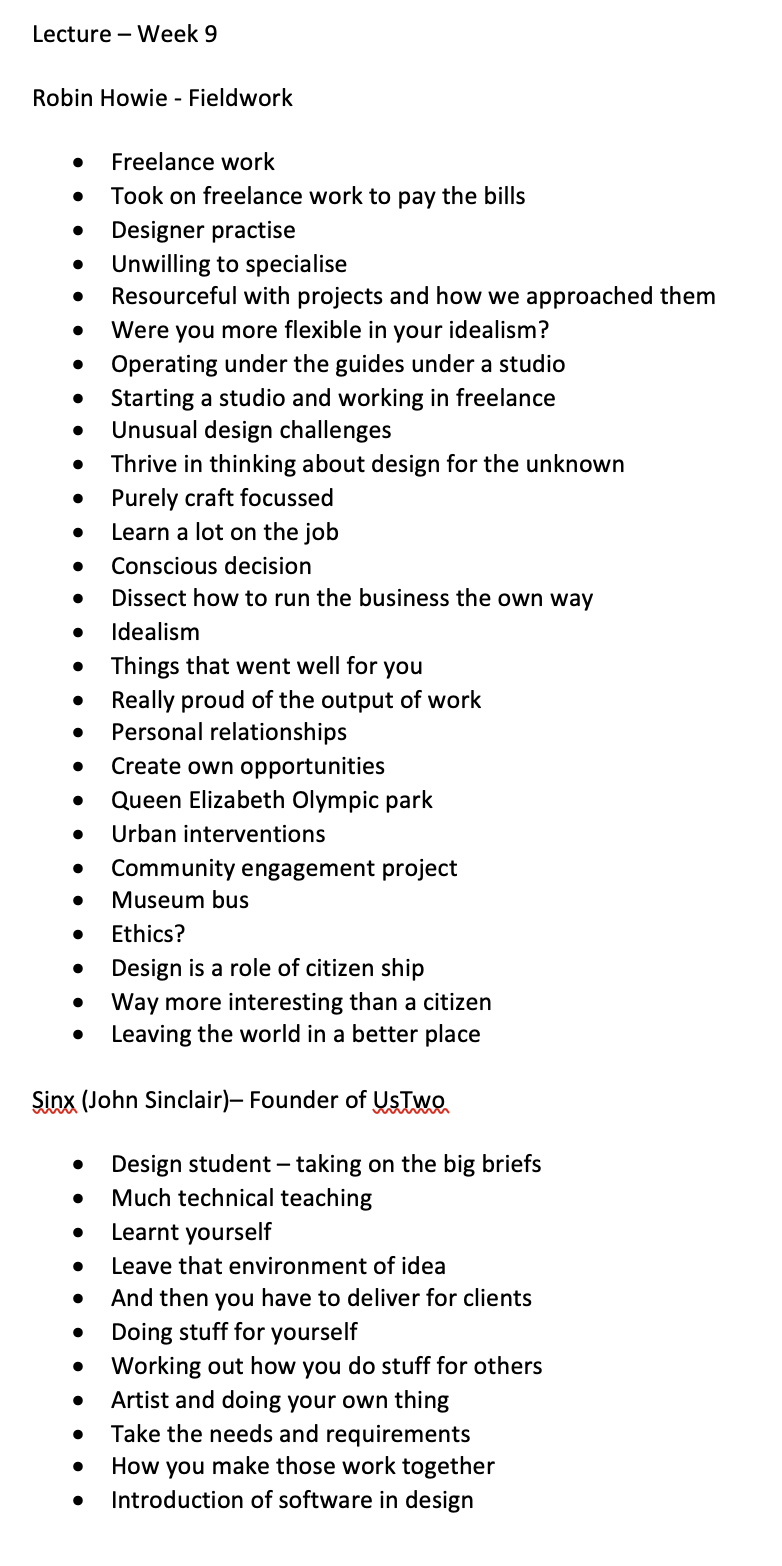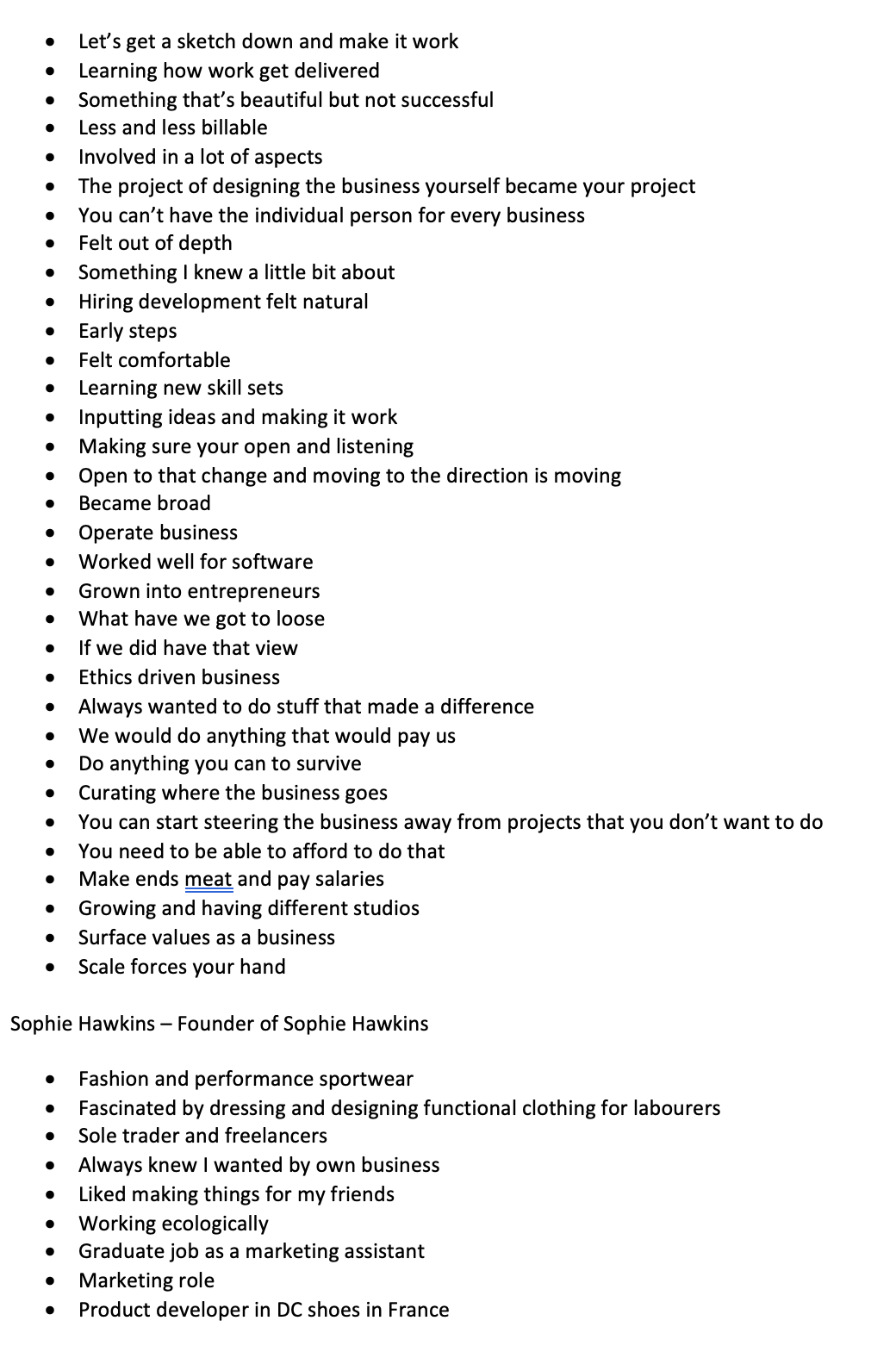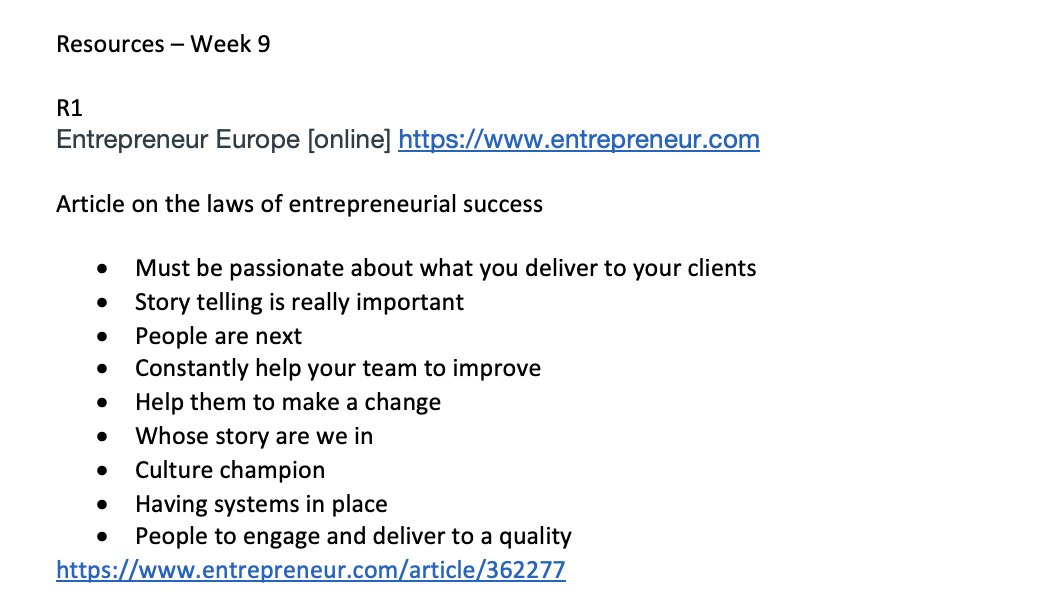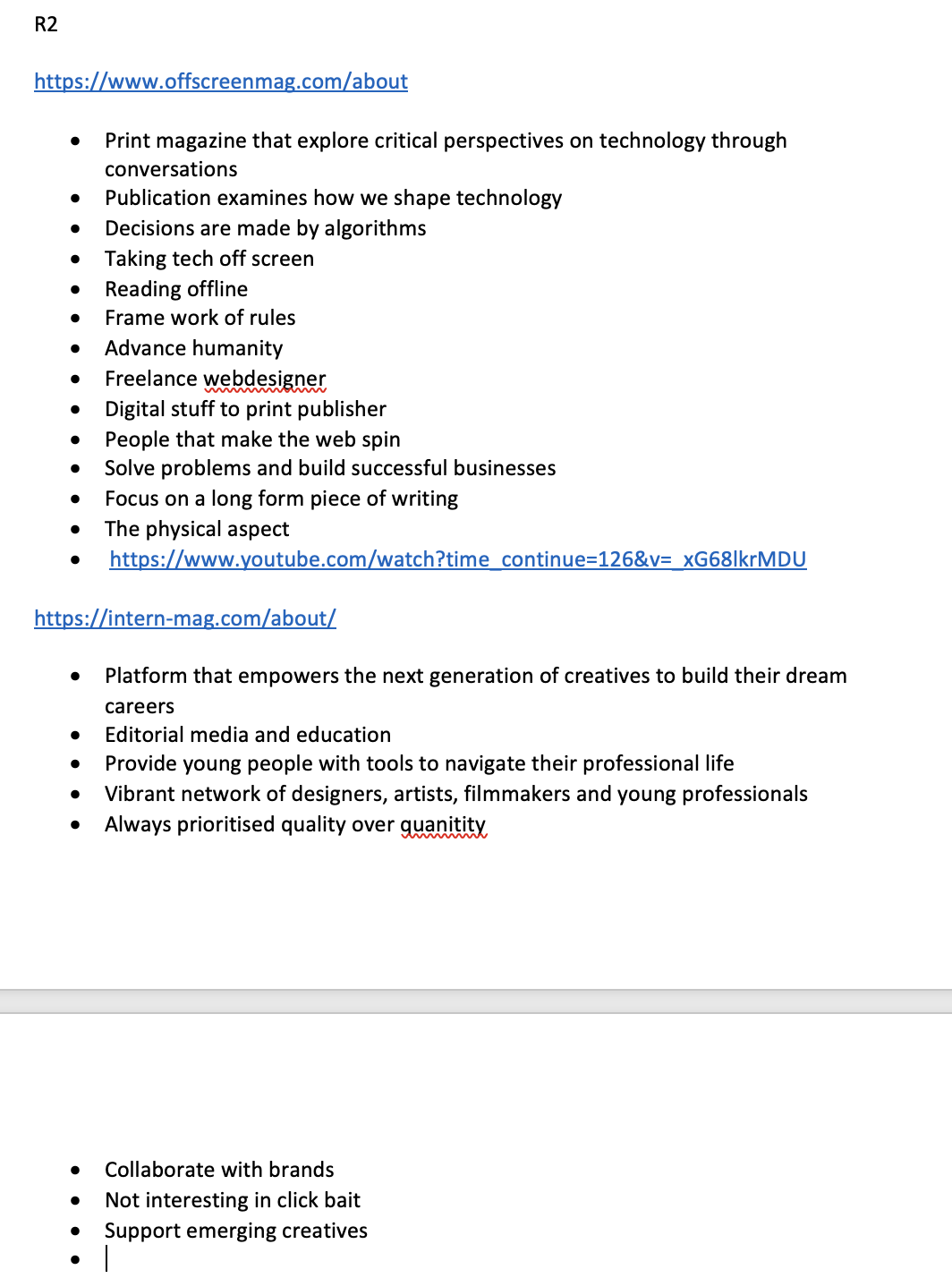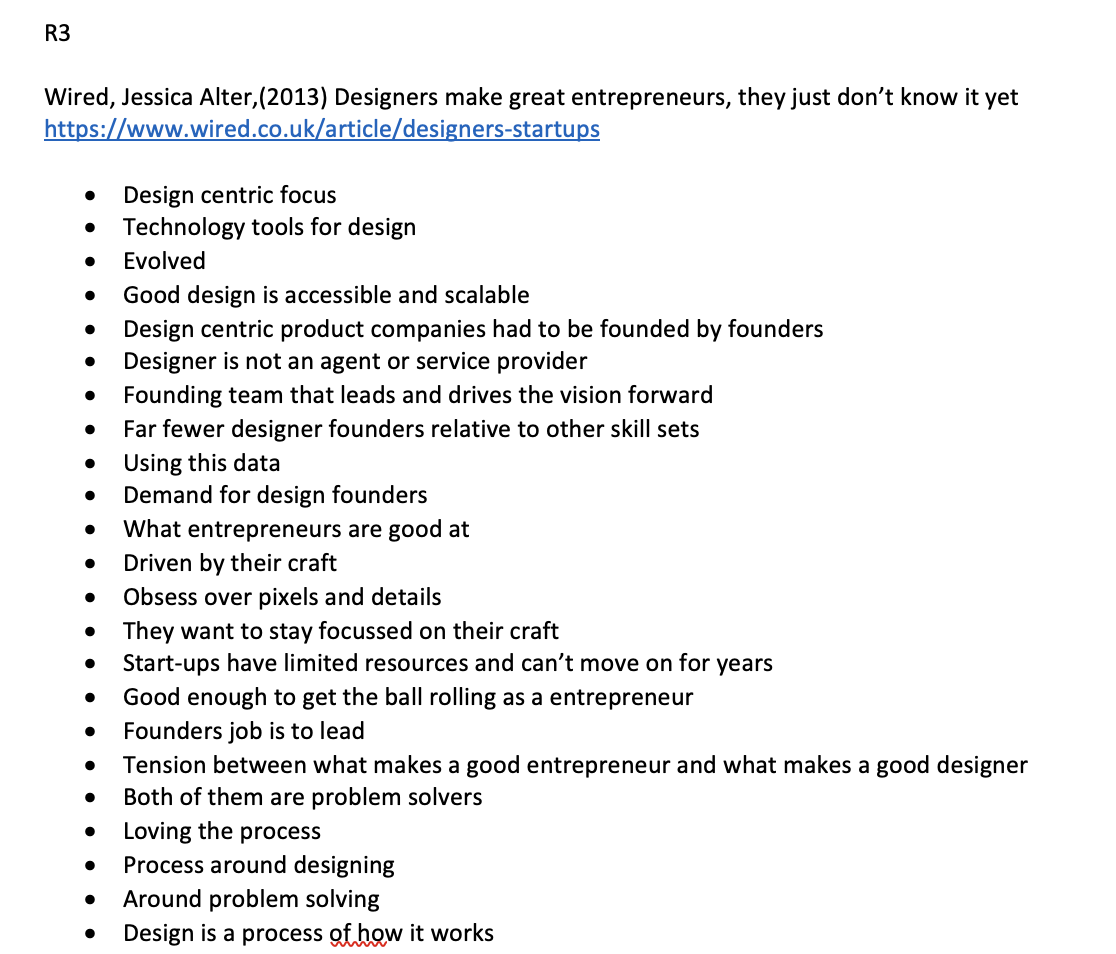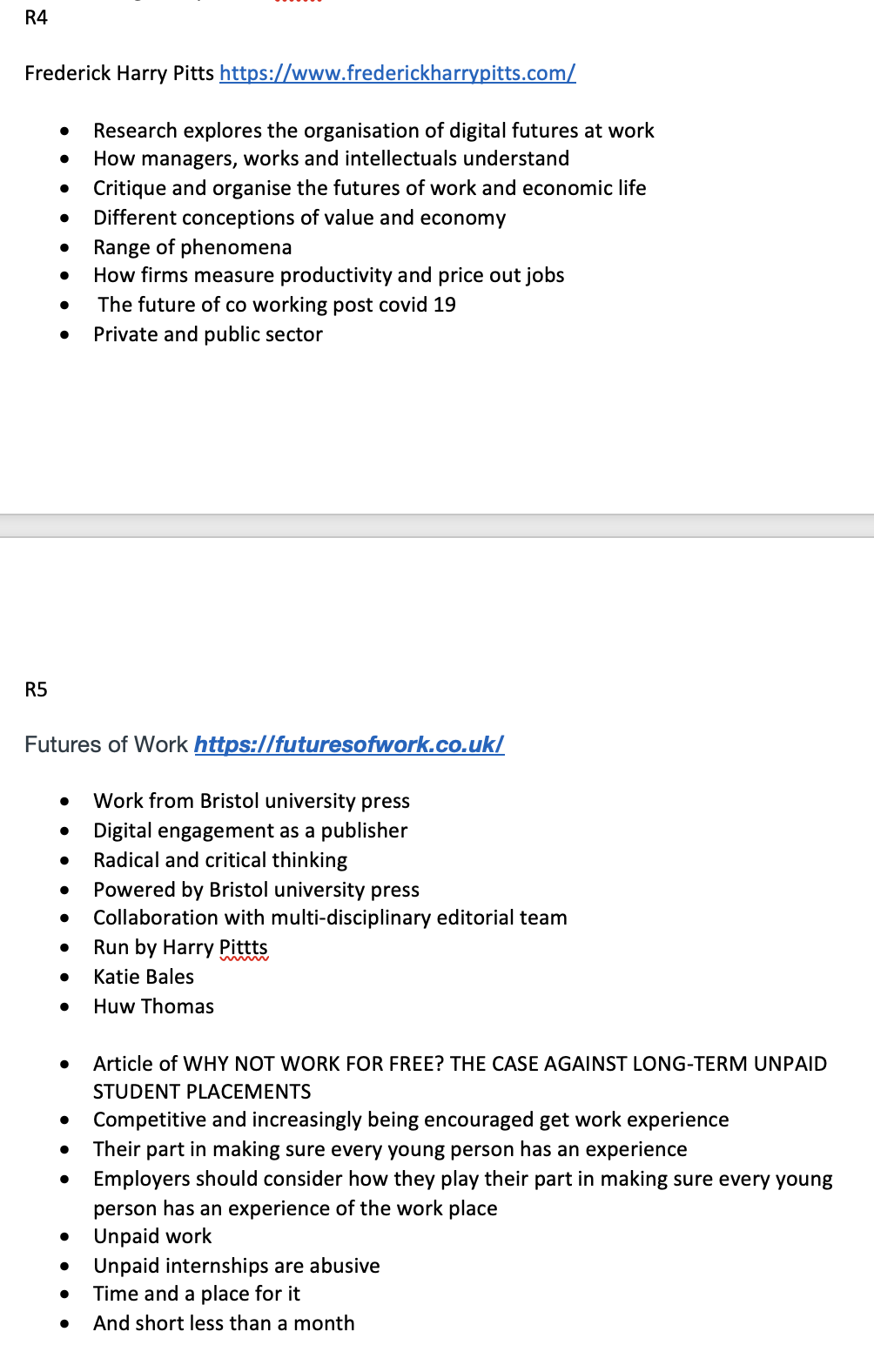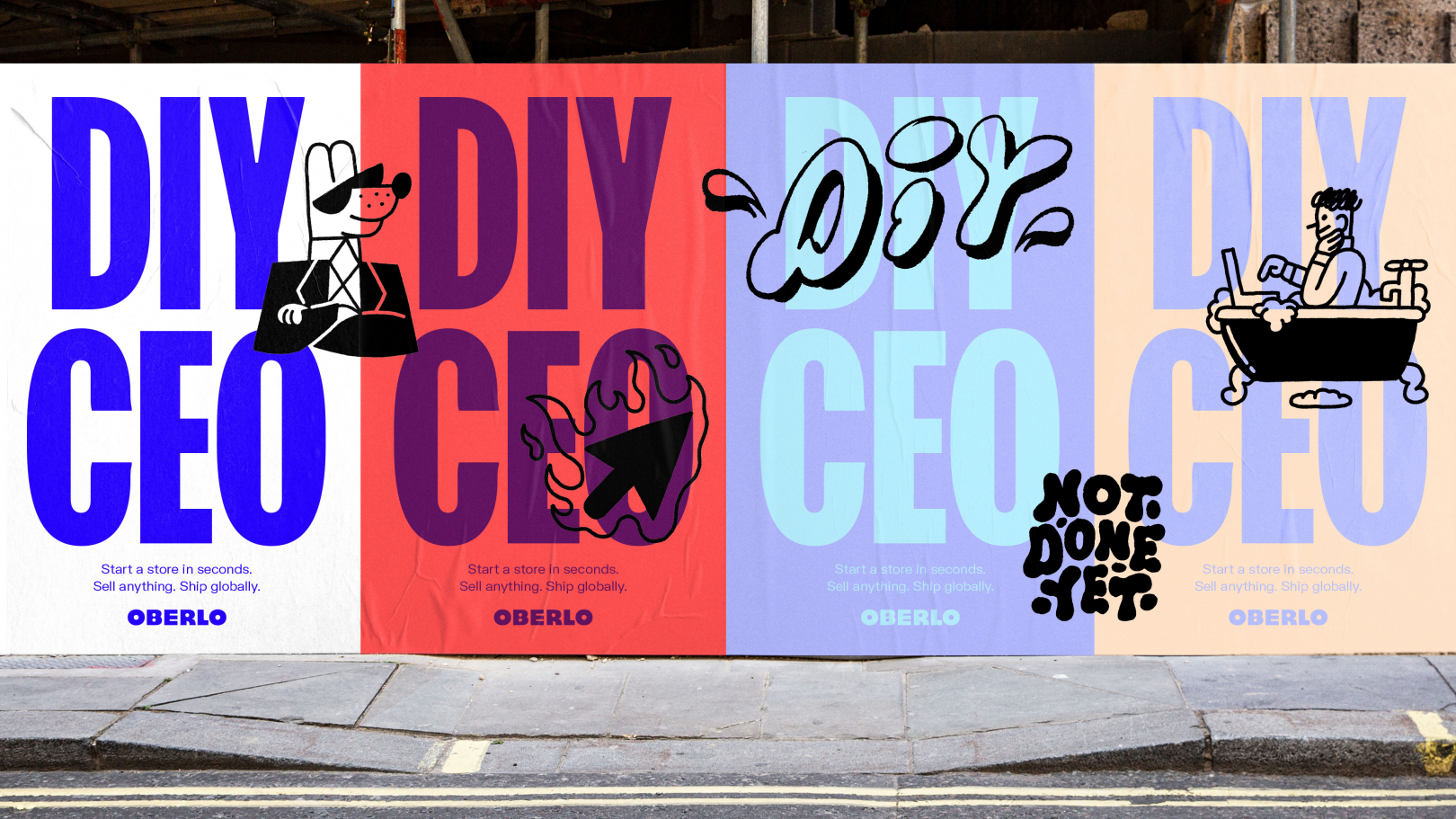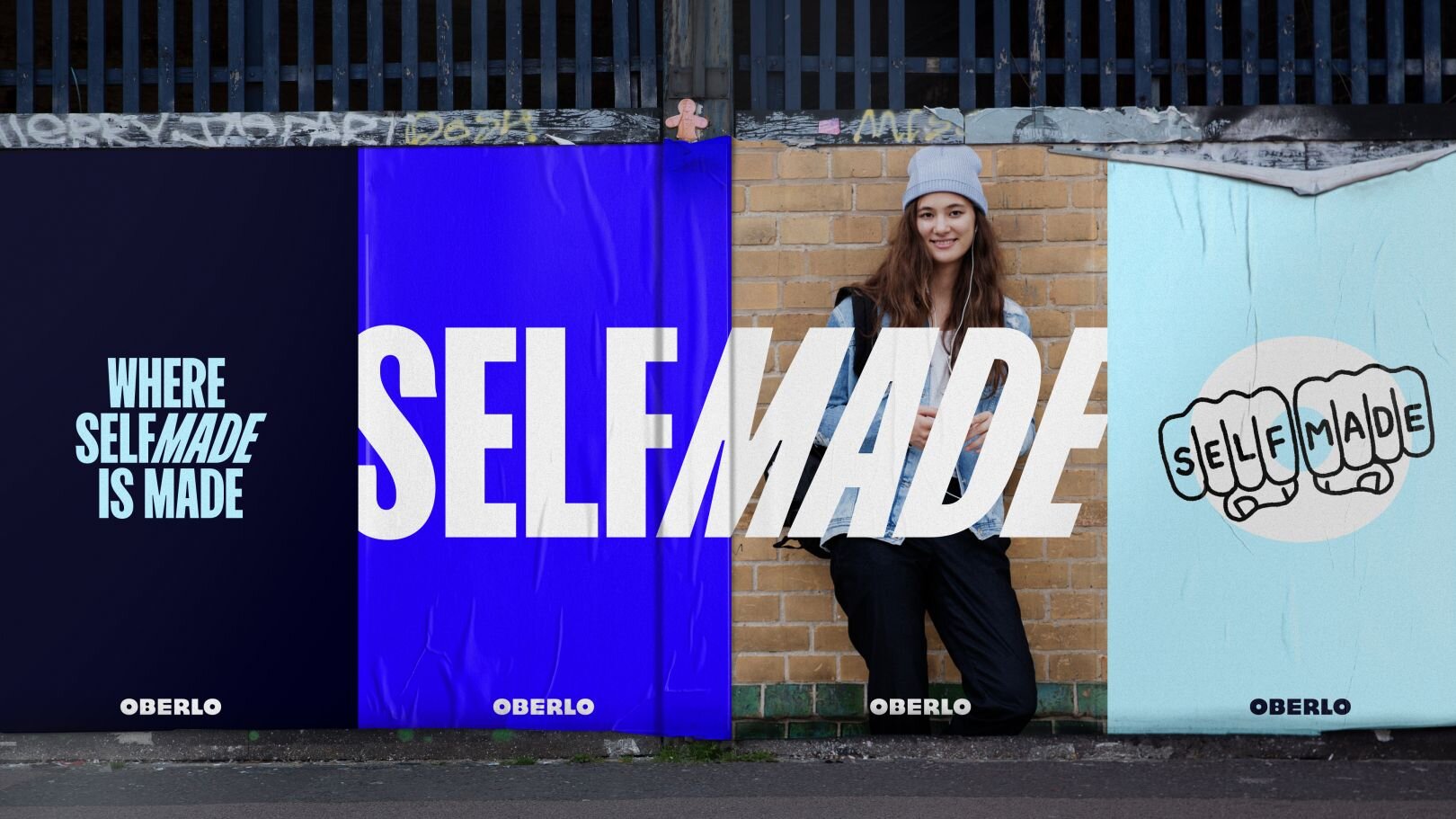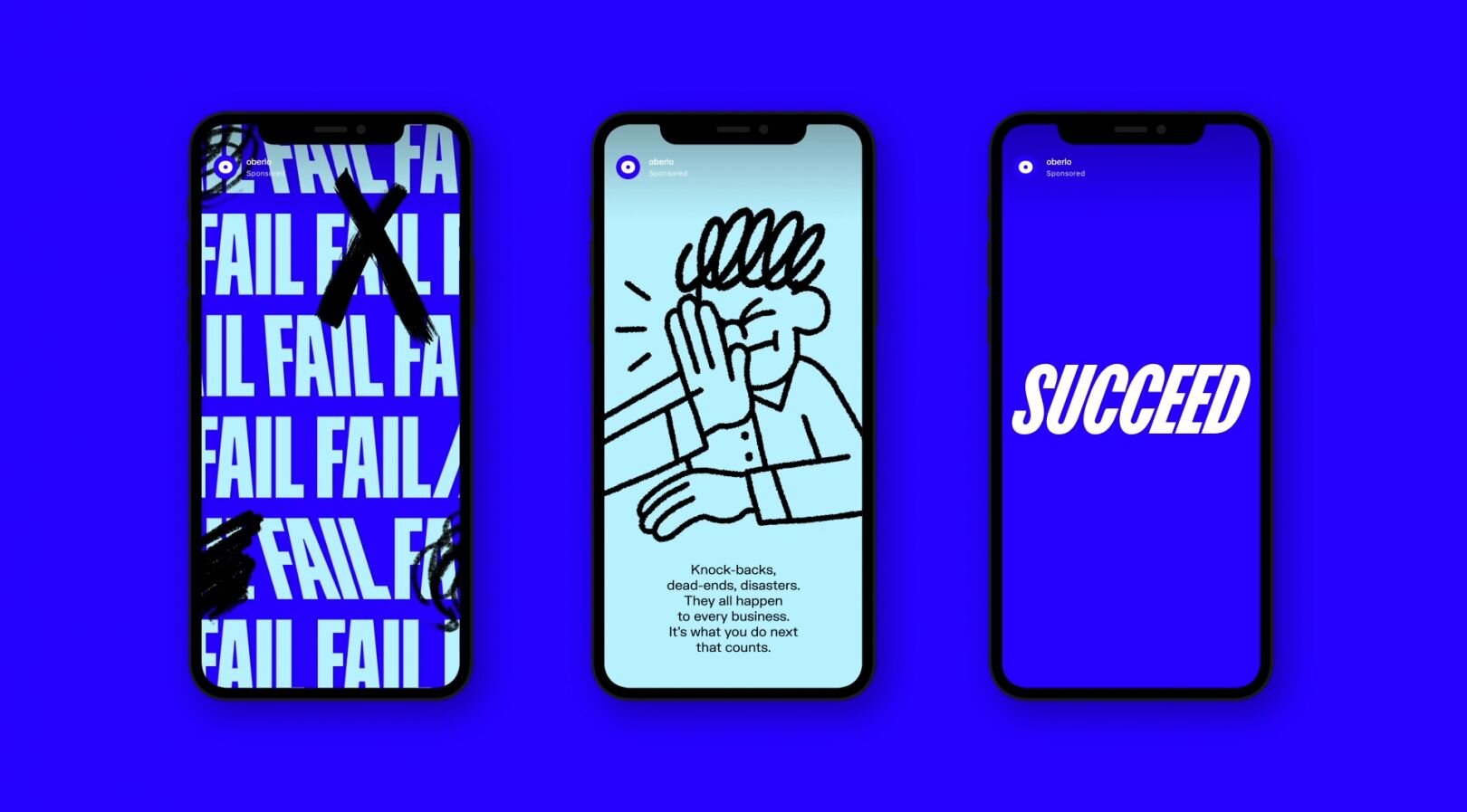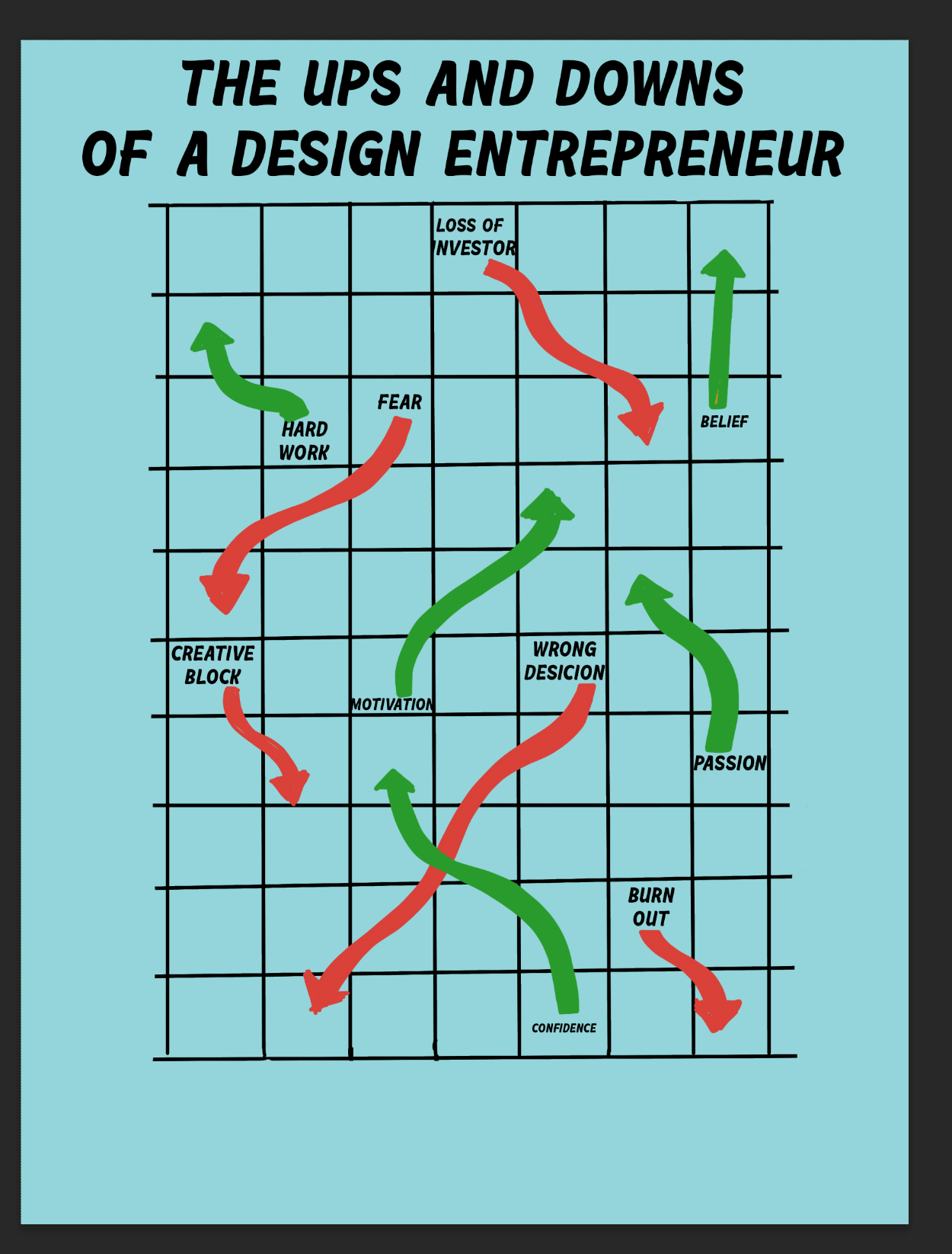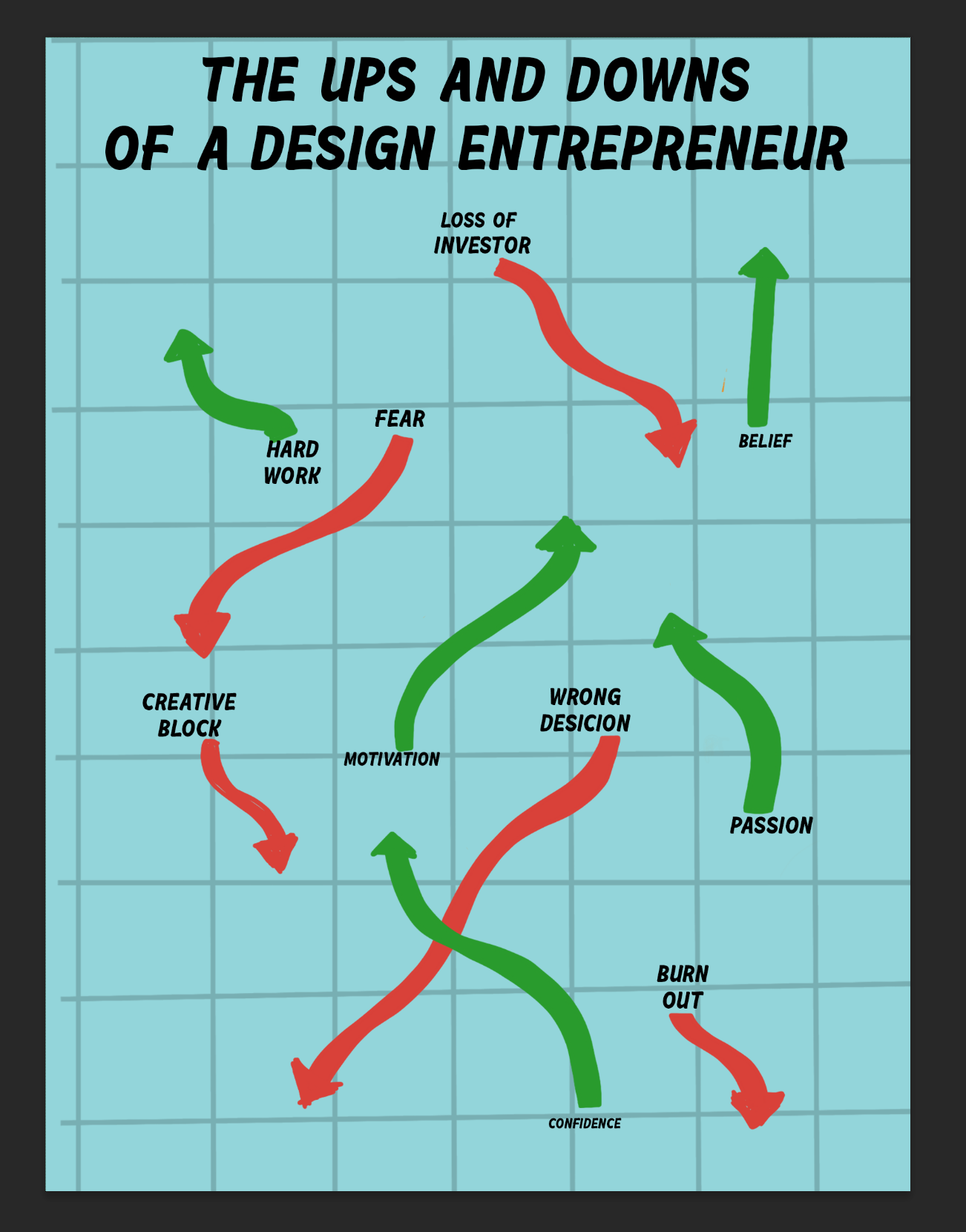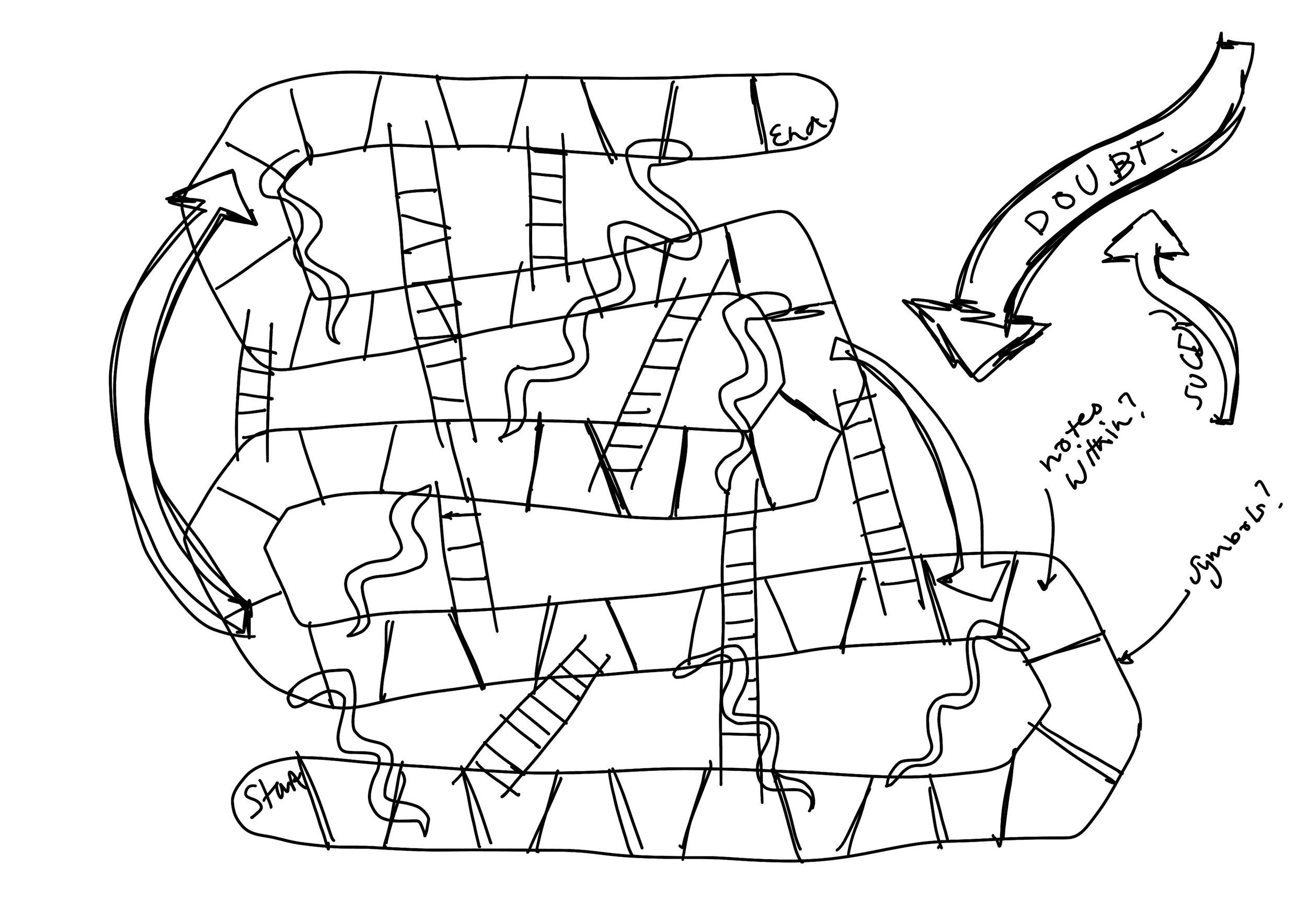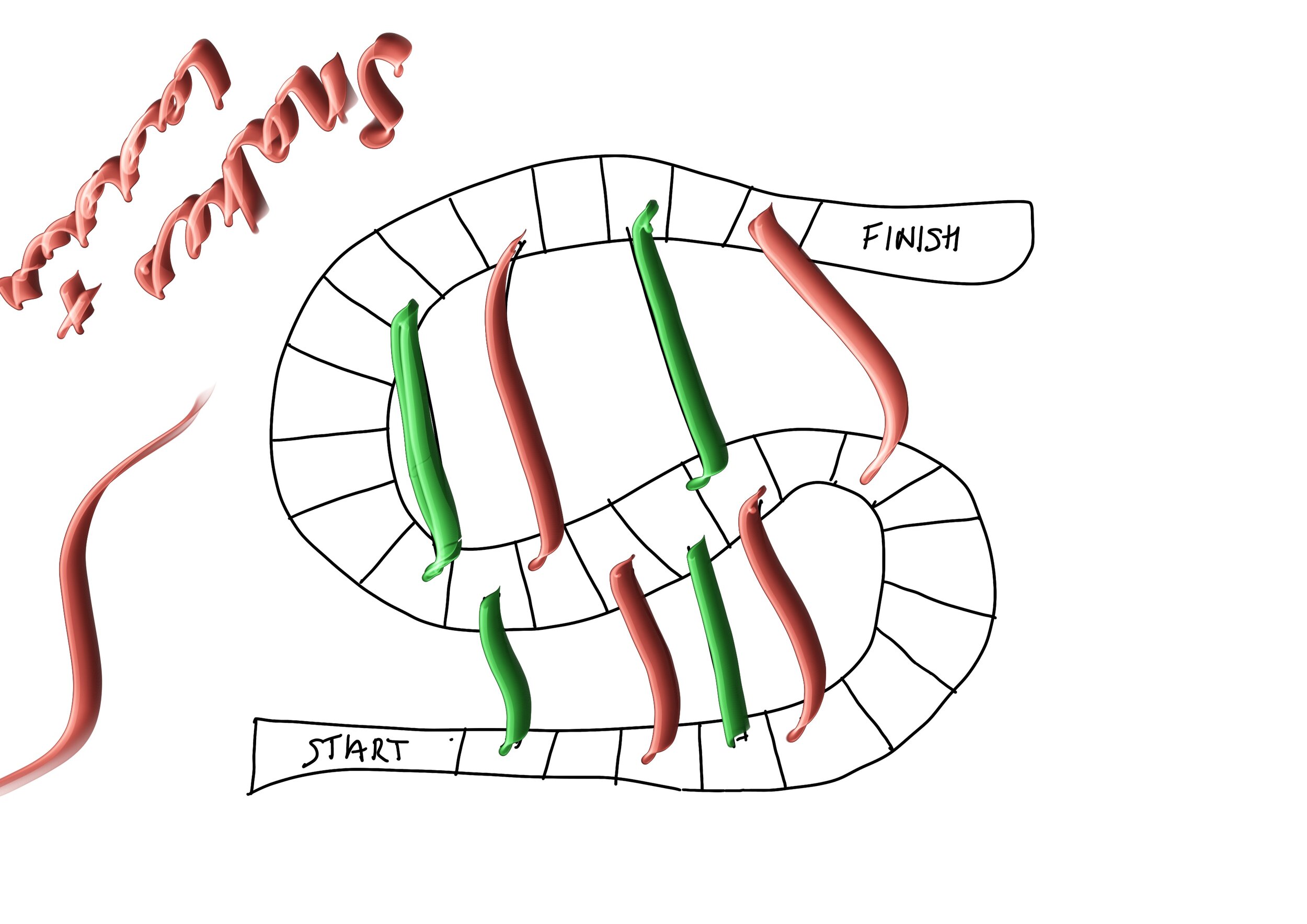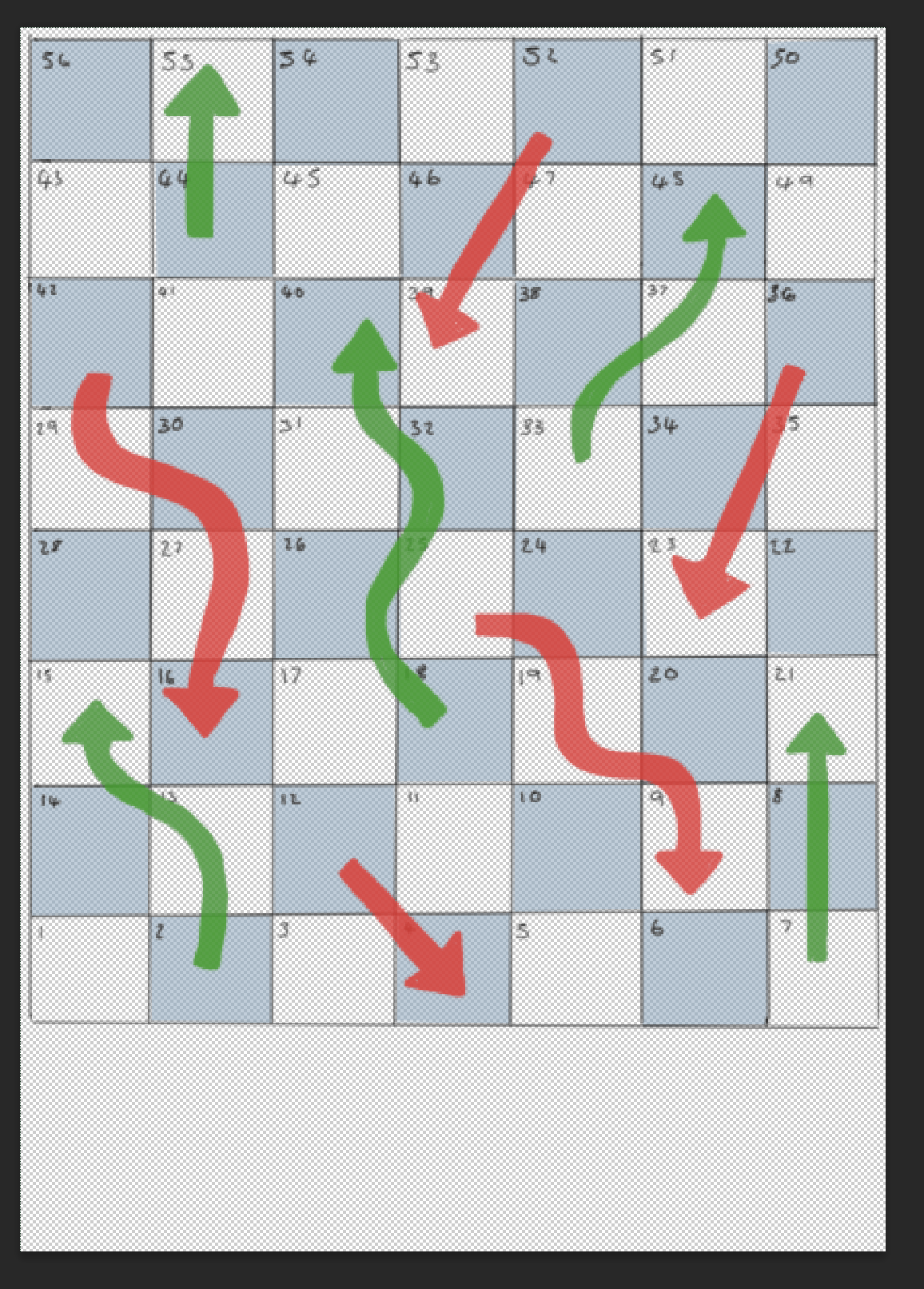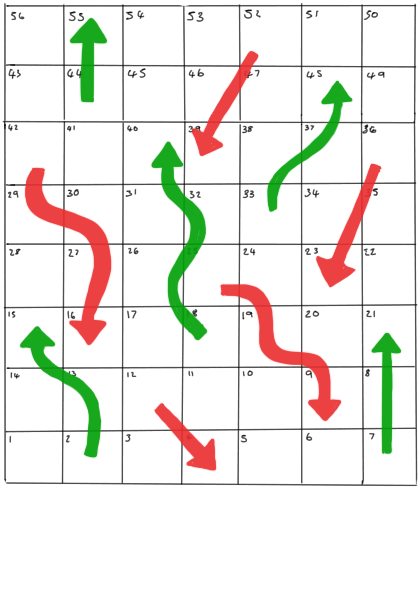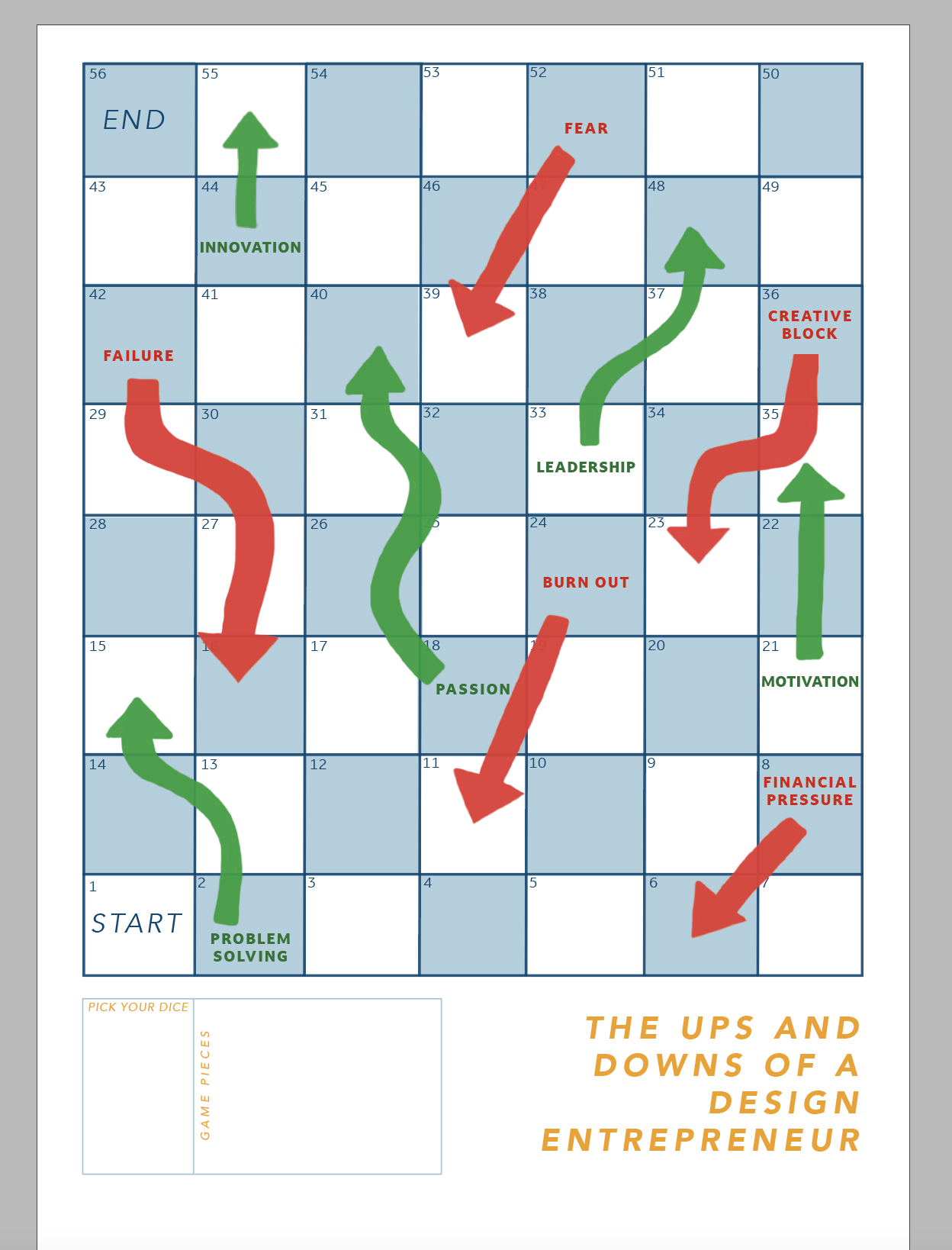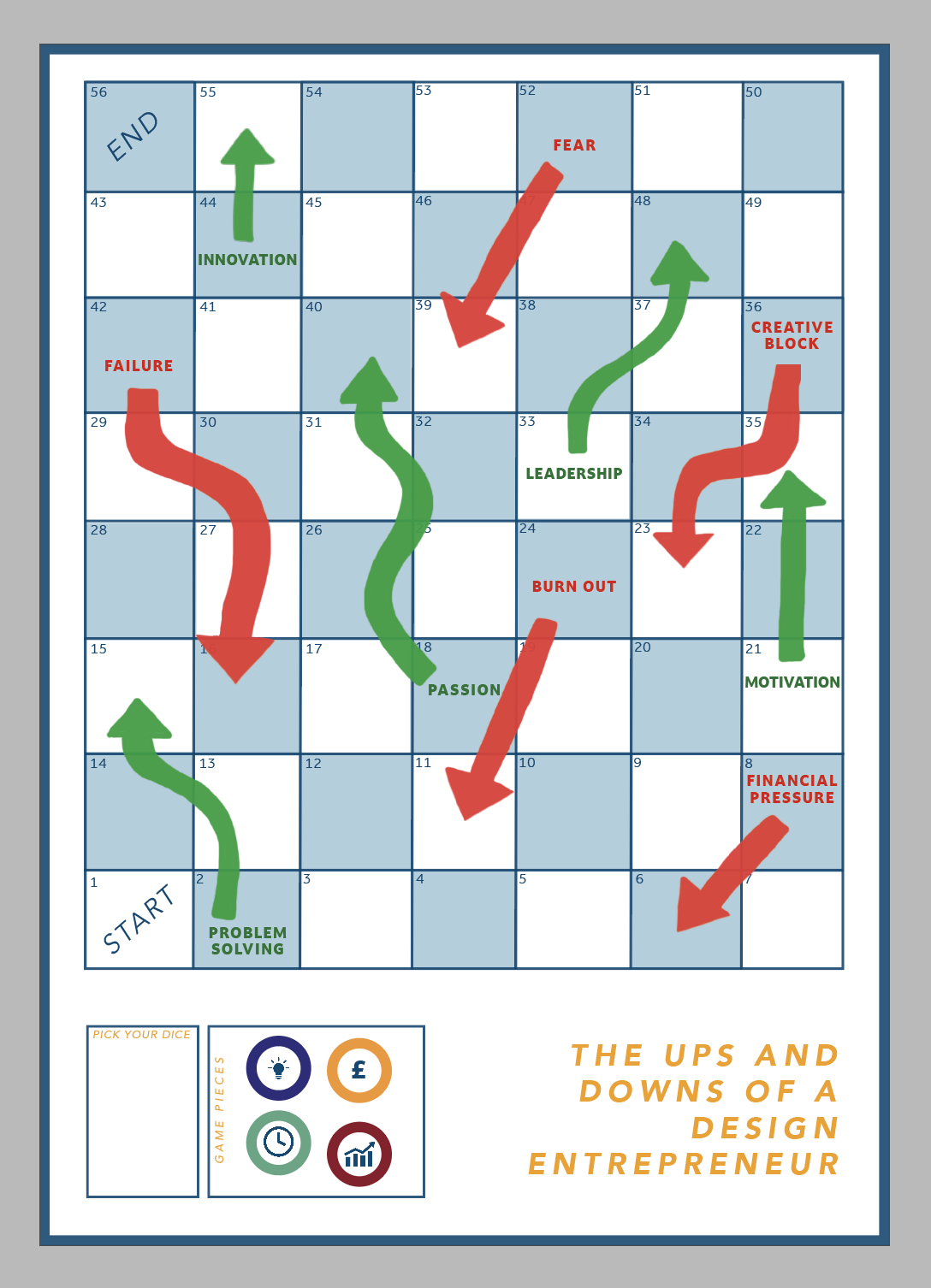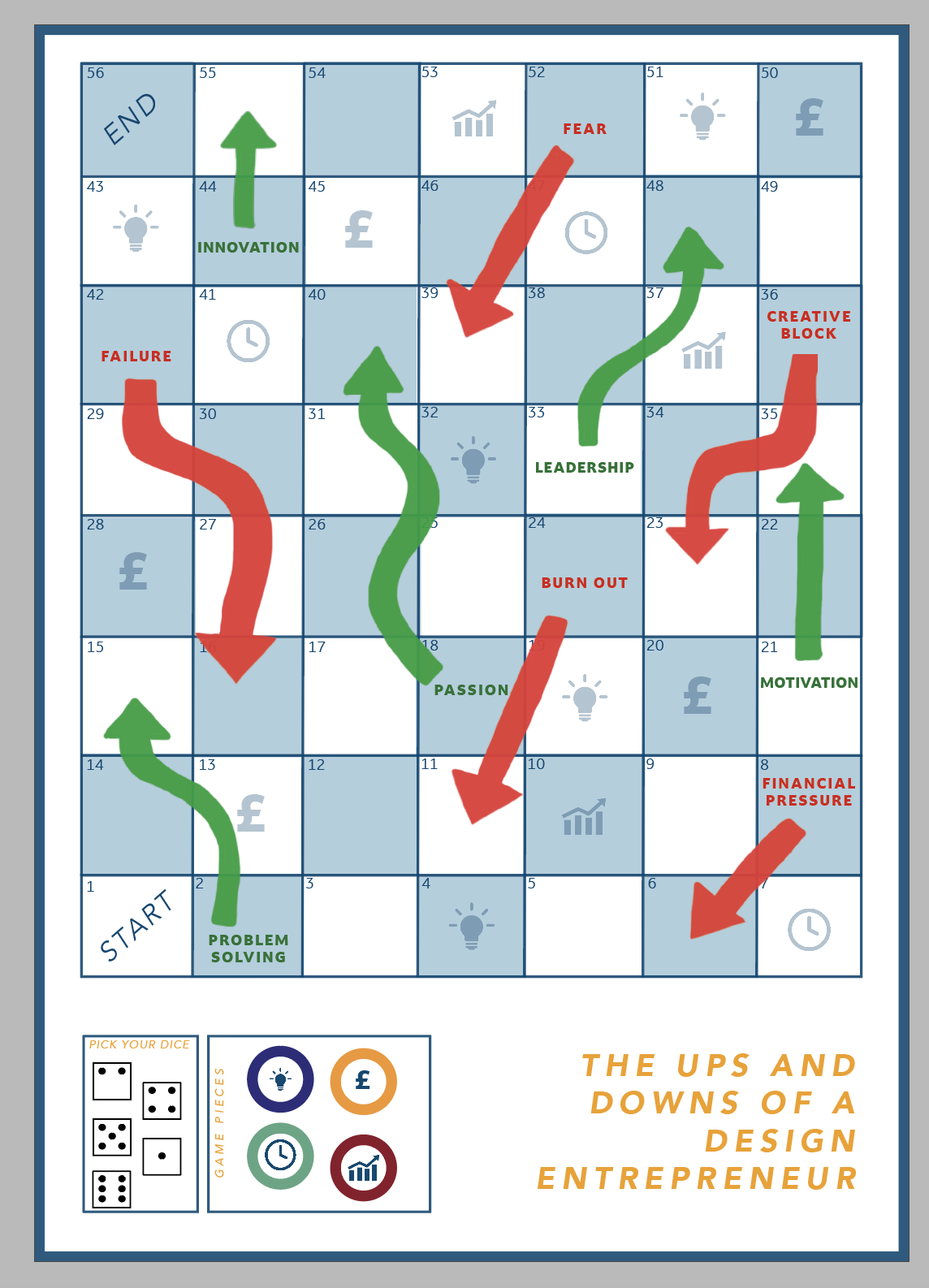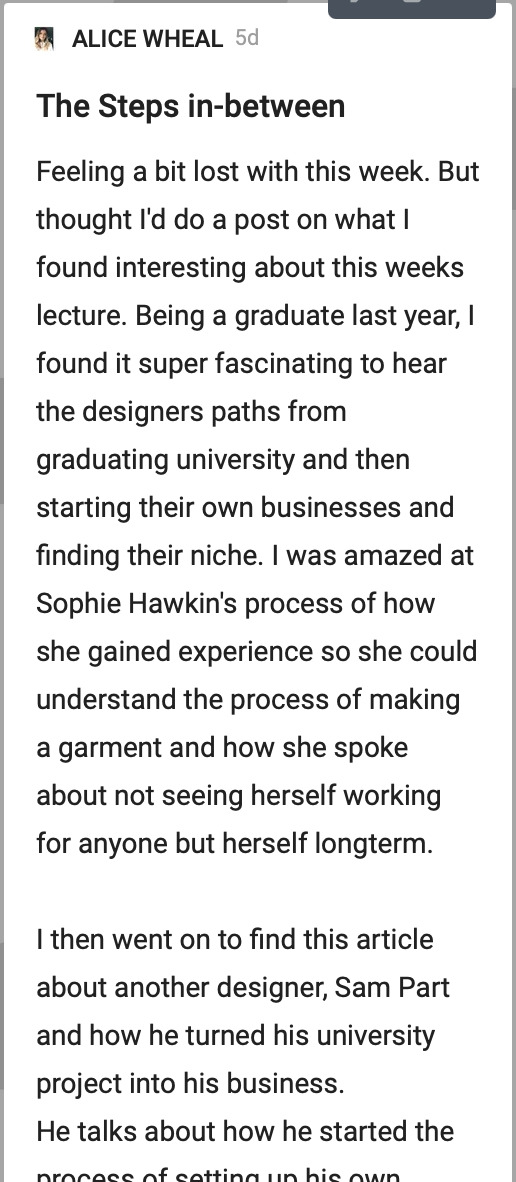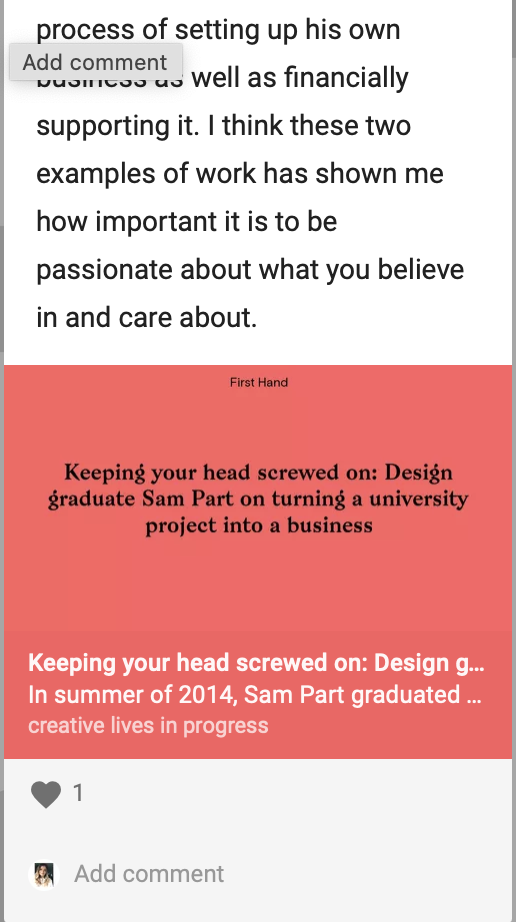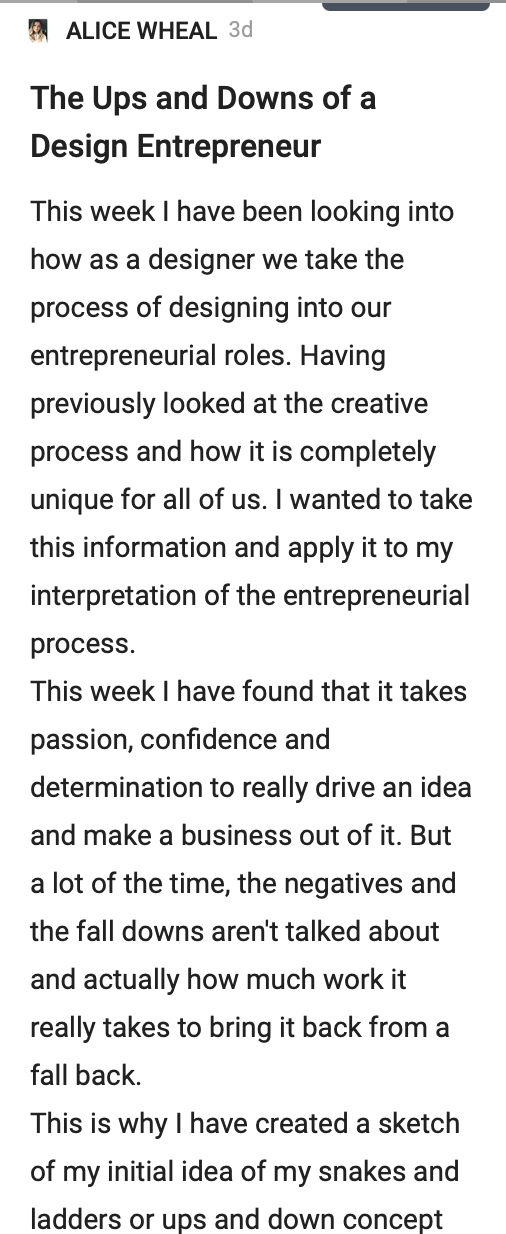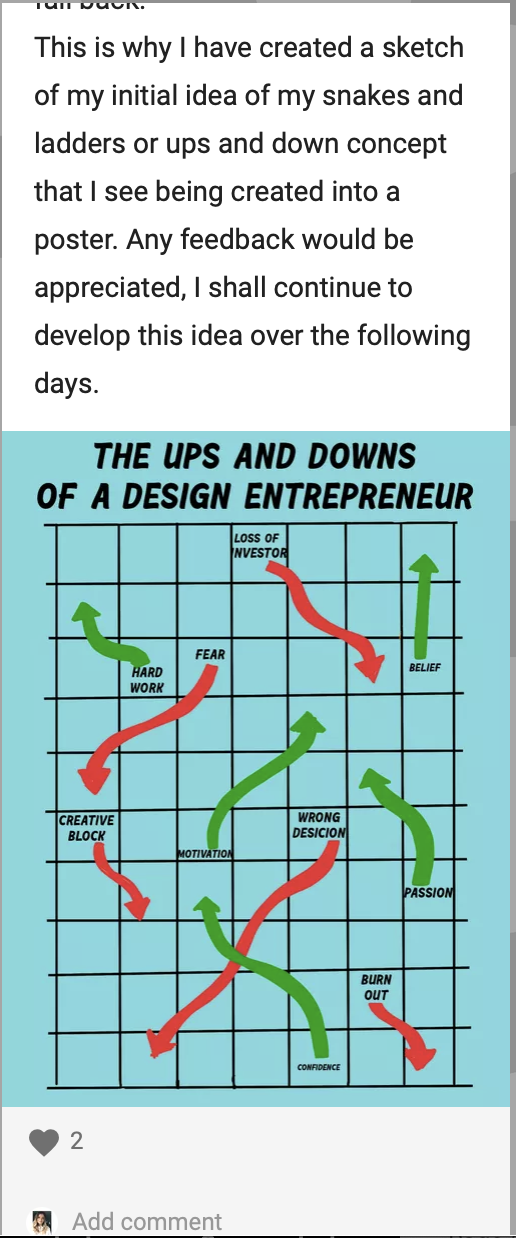Week Nine
Lecture Notes:
Lecture Reflection:
This weeks lecture was about the different stories and backgrounds of three different companies which have all had a different path with setting up their own businesses and finding their niche within the market. I think the main messages throughout the lecture was learning the steps and learning new skills to then set them up on their own, when they might have not necessarily been able to employ others to help them. I was particularly inspired by Sophie Hawkins and how she talks about the experience she gained in different areas before then setting up her business and knowing which areas and how she wanted to run it. I also think its inspiring that she did all of this whilst grieving her brother and how she sells her pieces to the people that she does freelance tailoring for.
Resource Notes:
Resource Reflection:
R1
Really helpful website with a lot of articles about different things to do with entrepreneur. I found a particularly helpful article about the laws of entreprenural success which is based on 3 characteristics, passion, people and place. I feel there is a lot to explore with this website so may continue to do so within the research.
R2
Within this second resource, there were a lot of magazines that were shown for the examples and i was particularly taken by 2 of them. the first being off screen magazine which focuses on the critical perspectives of technology through conversations. The magazine really focuses on taking the online world offline, solving problems but making it a physical component! The video below is great at talking about what they try to archive:
The other magazine that really took my interest was this one called the Intern magazine. Intern focusses on creating a platform as-well as a magazine that provides the tools to navigate young designers professional life. What i really liked about this platform is how they provide tutorials and other information that would be really helpful in deciding future careers.
R3
This was a really interesting real for why designers make good entrepreneurs and the main base of the article was how designers alongside entrepreneurs are both problem solvers. But the reason that a lot of designers don’t want to become entrepreneurs is because they want to focus on their craft which is why they get people to run the show for them. The design process is also very similar to the entrepreneur process.
R4 + R5
I have grouped together these last two resources as R4 talks about harry pitts and the things that he writes about and analyses through his writing. Majority of his writing looks at the future of working and the economic life. The R5 is the future of work press which harry pitts is apart of. It’s apart of the bristol university press and they look at the digital engagement as a publisher but write about important critical thinking. One of the articles that really stood out for me was the one on long term unpaid students. Having recently done an unpaid internship, I thought the facts and figures within this article were shocking and now i have learnt what not to do.
Research:
Research, analyse and distill the core characteristics, ethics and theory of entrepreneurship.
What is Design Entrepreneurship?
https://medium.com/ma-communication-design/what-is-design-entrepreneurship-7d3f08ea33eb
Within the article by Robert Lzicar on Medium, what is design entrepreneurship, it talks about how design entrepreneurship is how designers aren’t waiting for the client to bring them the problem, instead the designer defines the problem themselves and develops its solution as a business venture.
Firstly, designers act out of their own interest. they define their problem based on parameteres of the world that surrounds them. It also mentions how design entrepreneurs are rarely concerned about making money from their business. They tend to get more satisfaction when the sense and meaning of their solution are recognised. They also have an eye for growth. Less is more. There are no universal solutions. Use innovation and a clear profile to secure our social system.
Entrepreneurship and The Importance of Creativity
https://medium.com/the-mission/hacking-creativity-how-play-is-crucial-to-your-success-7e07896ea6e3
Within this article on Medium by Callum Alexander. It talks about how creativity is the centre of everything, especially when it comes to setting up your own business. He talks of three different trends that stand out to others when starting a business. Firstly, the outsider effect; a-lot of entrepreneurs aren’t in the same industry as they studied in. Everyone was just a novice. Secondly; Unique experiences. We have to change the way we think as society teaches us one thing when actually we want another. and finally playtime, increased lesiure time can improve the output of work. I thought this was interesting at highlighting different things that can set us apart when setting up a business.
Characteristics of Entrepreneurship
Within the above article by Vistage, It talks about the main characteristics of an entrepreneur.
Motivation
Passion - Make a difference
Vision of goals and what you want to achieve.
Confidence
Good at decision making - as-well as fast.
The designer as Entrepreneur
Notes from the above//
Either work at the company or be an entrepreneur
Being an entrepreneur isn’t for everyone
theres a lot of risk
without risking too much
disturbs the foundation
People are used to being the same
Change their reality
As a designer we do that and make people uncomfortable
the ability to have the execution
Creative, business and technical and marketing aspects
The technical side
Operationally
forced to go into entrepreneurship
becoming a better option than the alternative
jobs are declining and so people have to find opportunities
designers are a good business person
dont like looking at numbers
profit so you don’t have to look at the numbers
shared conceptual frame work
the people that do and the people that have needs
becoming the person thats connecting people
something you have to work through
designers - change of mindset
fear of the risk is very big
are not motivated by money at all
the wilingness
calculated risks
risk vs reward
why do you take all these chances
whats the worst that can happen
take smaller risk
cant make money of a process
Is it going to work
how to offer value consistantly
is this valuable
designers and fear
deep into the business of design
I think this podcast with Jose and Chris, really shows the fear and the willingness to go alone. They discuss how designers are often scared to leave the comfort of their own jobs to do it on their own but sometimes they are forced to due to the loss in jobs and the change within their current comfy business. Designers do make good entrepreneurs but often they don’t want to do the business side and only the design side.
Within the lecture this week different designers spoke about their transition from their studies to following their path and designing their own business. I was really interested in how graduates did this and their journey. Much like Sophie Hawkins, I feel Sam Part is also a passionate.
Sam Part
https://www.creativelivesinprogress.com/article/sam-part
Within Sam’s final degree show he made a mould of his head and turned them into lollipops. Since then this has now evolved to a company and employees 6 staff. Opportunity started when he was offered a shop space at the bottom of Selfridges. Opportunity to do his own thing, started just on passion, wrong decisions were made. Now he knows how a business is run and has learnt along the way.
Different approaches you can take, never stop talking about the idea. Find different skill sets. Find a similar business model. Now Part of a network of people.
“Never ever stop talking about the idea. Put yourself in interesting situations, and get talking to well-connected people. Keep talking and you might just find your co-founder.”
Young Entrepreneurs
https://www.creativeboom.com/inspiration/designstudio-rebrands-oberlo/
Think about entrepreneurs and setting up your own business from a young age, I found this article about the rebranding of Oberlo. It was needing a rebrand to be attractive, accesible and inspiring. When the design company ‘DesignStudio” were working with Oberlo, they talked about how they were struck with this honest view of the real world of entrepreneurism. No fantasy overnight stories, just hard work embracing failer and sucess. I think this is such a good point to get across that alot of entrepreneurs when they want to start their business they have no idea where to start. I really like the rebrand and would love to use this as inspiration for this weeks workshop challenge.
Female Direction
Within this week, I have also realised that there is a huge lacking of female entrepreneurs. This really intrigued me so wanted to just research some business / the ideas around the female entrepreneur.
Within the goverment article above, it talks about how only 6% of entrepreneurs in the Uk are women which is so much lower than other countries. Women are less likely to pursue entrepreneurship and are also less likely to pursue a business. Within this article it talks about how we can change these stats to then make a change within the UK. They have made multiple points about doing this, especially increasing funding directed towards female entrepreneurs and providing support. These are really interesting and I’d love to know the real reason why women are lower / half of what men are when setting up a business.
I wanted to also find an example that I used within a previous week so show a strong women led agency.
https://andwalsh.com/articles/all/walsh-launches-joining-the-1-of-women-founded-creative-agencies-/
Within this opening page for &walsh it talks about the emotions of setting up an all women’s agency, with the struggles of sexism, showing that they are unsupportive of each-other. There are also some scary facts of only 5-11% of creative director positions that are held by women and .1% of agencies that are women owned. The end paragraph that Jessica writes amongst the privileged things. She says that there will be obstacles and hates who don’t believe in you. Aswell as that she talks about how joy is not within the accomplishments that you achieve but the pursuits, discoveries and personal growth as well as the people you meet along the way. The final words she says is trust your gut and take the leap. I feel this is really aimed at entrepreneurs but also anyone that is having doubts.
Sail Creative
https://www.creativelivesinprogress.com/article/sail-creative
Sail Creative is a design studio that was founded with a purpose. Launched in 2016 by Mandy Barker, 3 workers haven’t let the pandemic slow them down. They label themselves as an activist studio. It was started when work they cared about for organisations were making a difference. Disrupt familiarity. They started with no money, no support and no assets. Passion and drive was needed to make the work feel right. Natural risk taker. Pandemic added to it and showed this small design studio that community is everything. “let yourself be open to failure. It’s often better to start something and see where you go, you don’t always need to know where you are going. Everyone gets ‘blank paper’ syndrome! Get immersive and enjoy the process.
The future will always be uncertain and he industry can be hard work. Just enjoy the ride – resilience is key. And if you want to make change, design activism is about being human, and doing things whilst they are relevant.
People are everything , so invest in your relationships. And trust your gut – it’s always right. You can do anything, you just have to be ok with being uncomfortable and make sacrifices for a while. The journey ‘there’ is the best bit (and that never ends).”
Fine Line between Design and Entrepreneur
https://www.mygreatlearning.com/blog/how-entrepreneurs-can-use-design-thinking/
Within the resources this week, it crossed my mind that there was a cross over between design processes and Entrepreneur processes. How can design thinking be utilised by entrepreneurs? Within this article by Tanuja Bahirat, they talk about the steps that must be taken for innovation and to achieve success. Those are the following:
“Empathizing – with the customers.
Defining – the challenges, needs, and wants.
Forming Ideas – different approaches are taken to come up with solutions for the problem.
Prototyping – products are made based on the different approaches
Testing – here the prototypes are tested and the faults plus benefits of the products are carefully studied”
I thought this was so interesting as its such a similar process for designers when they come up with ideas too. I guess as a lot of design entrepreneurs are also designing products for the public.
I also found another article on Medium which is how to think like a designer and act like an Entrepreneur by Amir Khella.
https://amirkhella.medium.com/think-like-a-designer-act-like-an-entrepreneur-70246e4ba6d5
This article is around the things that he wishes he’d been told when he was setting up his business. I think some of the points are really useful for this weeks research and workshop. Below i will list the different points and expand on them.
Don’t wait until you know what you are doing
“Act, get results, learn, adjust course, take more action”
No one is ever ready to start.
Fake it till you make it.
To overcome fear, create bigger fear
Fear of failure stops you from taking action
No one will pay you to follow your passion
Avoid the trap of passive income
Divorce your income from your time
Nobody cares how long it takes
Start with people not with ideas
they start with audience and fine a pain worth solving
Start a note book of pains and frustrations
Not all itches are worth scratching
to understand the market start freelancing
When everyone digs for gold selll shovels.
Execute as soon as you get inspired
be 10% better not 100% different
Go alone then together
everything is an experiment
quantity leaves to quality
give away great work for free
Dont sell help people buy
tell good stories
Workshop Challenge:
Create an information graphic, or diagram, or animation that, for you, highlights the effective definition and process of a being a design entrepreneur today.
Upload your diagram to the Ideas Wall and discuss the pros and cons of how risk, failure and innovation is built into a model for business success;
What is the impact of different cultural insights with regard to opportunity and potential?
Before starting the workshop challenge, I wanted to just summaries some of the research from this week. I have learnt this week that a designers process and a entrepreneurs process are very similar to how they get to the solution. As designers we act out on our own interests and find the problem this can often turn into a passion which mixed with confidence and motivation can be the best recipe for a design entrepreneur. I have also realised that Design Entrepreneurs need a lot of passion which fuels their projects but sometimes there is also self-doubt and fear that they aren’t able to do with all the ups and downs. When they are able to overcome this fear and act on what you are doing that’s when you can adjust the course to get the results that you need.
Taking all of this into consideration, my main ideas for this week are some kind of process / motivational posters for entrepreneurs. Below I have created a mood board with some of my ideas to outline them as well as a couple of sketches.
From this I was really interested in figuring out a board game poster like snakes and ladders that would show the ups and downs of the entrepreneur and what they have to face. This would also portray the ever changing enviroment.
Weekly Reflection:
This week I feel that i learnt a different side to being a design entrepreneur. Alot of the time i felt that being an entrepreneur you were often apart of a team but this week has shown me the dedication that it takes when you are doing it alone and the passsion that goes into creating a design project. I felt this weeks workshop challenge gave me a creative block as i was really strugggling with showing a process in the way that happens within the making of a design entreprenur. I feel that there is some cross over between the design process and a design entrepreneur because they are taking those strategies with them. I feel that my poster / game that i created shows that being a design entrepreneur the real ups and downs of the whole process.
